Research into the Sun’s atmosphere Understand article
Ever wondered what the solar wind means to us on Earth or what happens when the surface of the Sun erupts sporadically? Lucie Green from University College London's Mullard Space Science Laboratory, UK, describes some of the recent research into the Sun’s atmosphere.
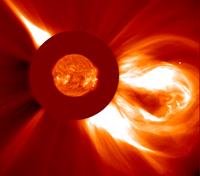
taking place
Image courtesy of SOHO
(ESA & NASA)
A special programme of research investigating the Sun and its influence on the Solar System is currently underway. Initiated by the United Nations, the programme is called International Heliophysical Yearw1 and scientists all across Europe are taking part. One topic of interest is the Sun’s atmosphere; there are many questions about our local star still to be answered.
One of these questions arose in 1869, when spectroscopic observations of a total solar eclipse revealed a spectral line which was unrecognised in laboratories. Initially believed to be a new element and provisionally named ‘coronium’, it was later found to be produced by highly ionised iron ions, which need very high temperatures (of about 1 million Kelvin) to form. This discovery in 1939 was the first indication that the gases in the solar atmosphere were much hotter than the surface temperature of 6000 Kelvin. This then presented a puzzle. As you move away from the heat source (the core of the Sun), the temperature should drop. This is the case until you reach the top of the photosphere, but then the temperature starts to increase with distance from the core. This goes against the second law of thermodynamics; a cooler body cannot heat a hotter one. The question then arises, what heats the solar corona? This is now known as the coronal heating problem.
Despite the discovery of the first coronal emission line at a visible wavelength, most of the emission from the corona is at ultraviolet and X-ray wavelengths. When the space era began in 1957, X-ray telescopes on rockets and satellites were able to collect data from outside the Earth’s absorbing atmosphere and allowed scientists to start studying what processes are at work. Observations quickly showed that bright X-ray emission was seen in the regions of the Sun’s atmosphere where the magnetic fields are the most concentrated. Is there a link between the magnetic fields and the heating?
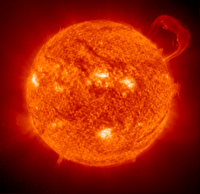
the SOHO spacecraft
Image courtesy of SOHO
(ESA & NASA)
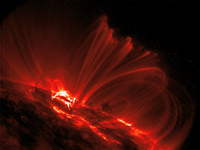
atmosphere which are created
by the magnetic fields
Image courtesy of SOHO (
ESA & NASA)
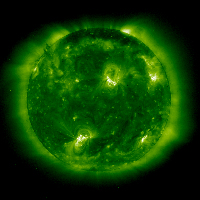
spacecraft
Image courtesy of SOHO
(ESA & NASA)
Observations taken from spacecraft such as the European Space Agency/National Aeronautics and Space Administration SOHO mission in 1995 are being used to test a number of theories. The theories fall into two categories: stressing models in which energy is extracted from magnetic fields that thread the corona, and wave models in which energy is deposited by waves that propagate up from below. The favoured idea at the moment is that the energy is derived from the magnetic fields which are constantly being jostled and moved around, but research is ongoing.
One consequence of the Sun’s hot corona, along with its high thermal conductivity, is that it is constantly expanding into space. This expansion is called the solar wind and there are two types: the slow wind which travels at about 400 km/s and the fast solar wind which travels at about 800 km/s. Currently, neither the acceleration mechanisms nor the locations of these two types are really understood, but both are being investigated.
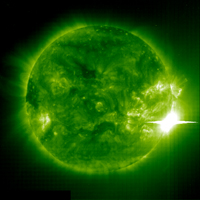
the Sun’s atmosphere
Image courtesy of SOHO (
ESA & NASA)
The solar wind blows over all the planets and other bodies in the Solar System. Some planets, like Earth, generate their own magnetic field: those that have either a core of molten iron (like Earth) or an atmosphere of hydrogen that is so compressed that it acts like a metal (like Jupiter). This forms a magnetic bubble around the planet, around which the solar wind normally flows. The planet and its magnetic field act like a boulder in a river, deflecting the stream. However, the solar wind carries with it a magnetic field and if this has a strong southward orientation, it lines up with Earth’s magnetic field. During these times, enhanced auroral displays (the Northern and Southern Lights) are produced. Work is being carried out to determine how the energy from the solar wind is transferred into the Earth’s magnetic field and atmosphere.
Research is also being carried out to see how the solar wind affects planets without a magnetic field. For example, the Venus Express mission is currently in orbit around Venus and is measuring the erosion of the Venusian atmosphere by the solar wind.
The most dramatic form of activity that takes place in the Sun’s atmosphere are huge eruptions of plasma and magnetic field known as coronal mass ejections, or CMEs. Originally discovered in the 1970s, it has since been shown that their frequency varies cyclically (with what is known as the solar cycle): CMEs occur a minimum of once every three days, and a maximum of three to five times per day. These eruptions can be directed towards Earth and, just like with the solar wind, a connection to Earth’s magnetic field can be made. Under these conditions, severe consequences are felt on Earth; heating and expansion of the Earth’s atmosphere leads to changes in satellite orbits. The very real effect of CMEs makes them incredibly interesting to study and there is currently a fleet of spacecraft observing the Sun and Earth to do just this.

Image courtesy of Hinode
JAXA/NASA
The cause of CMEs is known to be related to the Sun’s magnetic fields, which are created by electric currents in what is called the solar dynamo, deep in the interior. Bundles of concentrated fields rise and emerge through the photosphere and extend up into the corona. This magnetic field is continually being injected into the atmosphere and it is thought that CMEs provide a way to remove it and prevent a build-up. Studies are being carried out, with spacecraft such as SOHO, TRACE, STEREO and Hinode, to monitor how the magnetic field structures change over time.
The STEREO mission consists of two spacecraft orbiting the Sun in a way that allows them to move away from Earth in space (one orbit is slightly closer to the Sun than the Earth’s, and one slightly further out). This means that the two spacecraft view the Sun from different positions in space and just as our two eyes give us a sense of depth and perspective, the STEREO spacecraft are giving a 3D view of the erupting magnetic structures (see image). The 3D view is being used to try and work out the physics of the eruption using knowledge of the structure of the magnetic fields. STEREO is also helping predict which CMEs will collide with Earth. This knowledge could be used by satellite operators or organisations that run electricity grids: for example, the orbits of satellites could be particularly closely monitored when it is thought that CMEs will collide with Earth.
The Hinode spacecraft is the equivalent of the Hubble Space Telescope for the Sun, and it is allowing the study of the evolution of the immense atmospheric magnetic structures over time in great detail. It is thought that the only way to get enough energy to expel the billions of tonnes of solar material that make up a CME is by using energy stored in the twisted and distorted magnetic fields. Hinode is making measurements of how twisted the field is and the results are being combined with those found using STEREO. Once we understand why CMEs occur, we can start to predict which magnetic structures will erupt and eventually which ones will have the greatest effect on Earth.
The continually blowing solar wind and sporadic CMEs mean that Earth is always feeling the presence of the Sun. In fact, it can be said that we are sitting in the atmosphere of the Sun, which is expanding into the Solar System. So, as well as the fundamental science that is being carried out to understand our local star, we want to understand our place in the Solar System too.
Web References
- w1 – For more information about the International Heliophysical Year (2007-2009), see: www.sunearthplan.net





